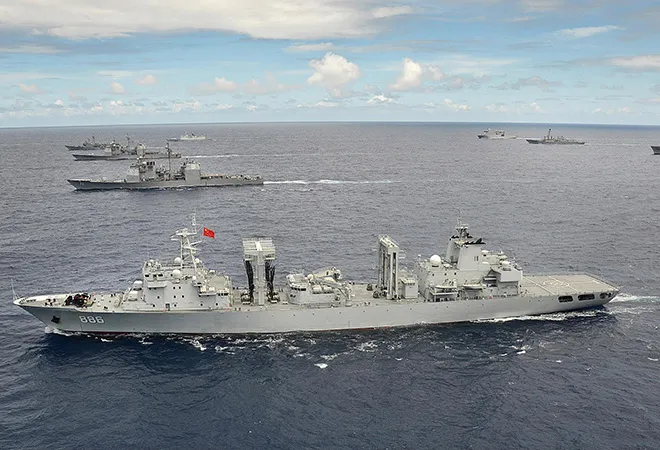As the presence of Chinese research ships and fishing fleets grows in the Indian Ocean, India’s Chief of Naval Staff, Admiral Karambir Singh, has warned against “any maritime activity that deviates from the norm or rule-based order, that can cause regional instability”.
Speaking at the Raisina Dialogue in New Delhi last month, he added that “if there is anything that impinges on our national interest or sovereignty, we will have to act”.
The warning comes after an Indian warship expelled the Chinese research vessel Shiyan-1 from Indian waters last September. Local media said the military reacted swiftly as it was possible that the Chinese vessel might have been spying in India’s exclusive economic zone (EEZ).
It is not unusual for foreign research vessels to operate in India’s near seas. American survey ships have occasionally conducted information-gathering operations in Indian-administered waters, leading New Delhi to protest.
Rarely, however, have Indian denouncements of foreign maritime activity been as vocal as in the case of Shiyan-1. Chinese officials insisted the vessel “was conducting acoustic propagation experiments and hydrologic environment measurements on the high seas of the Indian Ocean … and only sailed through the Indian EEZ on the way to and from the experimental area”.
To be sure, India and China have no real dispute over maritime surveillance in the Indian Ocean – and nowhere near the way that China and the United States contest the issue in the South China Sea.
New Delhi and Beijing hold similar positions on foreign maritime presence in their EEZs, seeking greater control over near coastal activity. Both interpret the United Nations Convention on the Law of the Sea in similar ways, demanding that foreign navies provide notification and seek consent before conducting any activity in their coastal waters.
Despite growing anxiety over a Chinese presence in the Indian Ocean, Indian leaders have avoided finger-pointing, which Chinese leaders appreciate. Yet, Beijing is wary about New Delhi’s moves to gradually expand its combat naval patrols over key sea lanes and chokepoints in the Indian Ocean.
It seems plausible that what Indian observers see as provocative Chinese deployments in the Andaman Sea are a subtle caution from Beijing that Indian efforts to dominate littoral South Asia are unacceptable; a gentle reminder that the Indian Ocean is not Indian, and that the Chinese constabulary presence is entirely legitimate.
There is some evidence to back this hypothesis. First, Chinese deployments in India’s neighbourhood mainly involve civilian research and survey vessels that have mostly stayed clear of Indian-administered waters. On the rare occasion that a Chinese vessel entered India’s EEZ, it has avoided Indian island outposts.
Second, unlike in the South China Sea, where China has sought to dominate, Beijing has been respectful of Indian interests in the Bay of Bengal. Chinese warships have not challenged Indian sovereignty or approached Indian territory with malignant intent. Nor have Chinese vessels impeded the passage of Indian merchants in the regional sea lanes.
Far from a classical sea denial strategy – as some Indian analysts see it – the Chinese game plan seems to be one of counter-denial, using non-military platforms to prevent India from executing its denial strategy against China’s navy in South Asia.
To this end, China’s naval leadership has ramped up civilian vessel presence in the Indian Ocean, but scaled back on its warship presence in the Bay of Bengal. There have also been fewer Chinese submarine sightings close to the Andaman and Nicobar Islands recently, an indication that the Chinese navy does not want to be seen as an aggressor in India’s near seas.
It seems that what China really wants is a “grand bargain” that would allow itself and India to exert some control over their regional littorals – the Bay of Bengal and South China Sea – with neither side attempting to impede the other’s maritime trade and economic activity.
Furthermore, China seeks an understanding with India to allow each other to maintain, in their presumed spheres of dominance, constabulary presences necessitated by their economic interests. This understanding would probably not extend to the Arabian Sea and Western Indian Ocean, spaces that China regards as more politically neutral.
If India were to agree to a deal of sorts with China, the implications would be significant. Having endorsed the Indo-Pacific concept and made a strong case for a rules-based order in the Asian commons, New Delhi would find that it cannot join its Quad partners in protesting against Chinese aggression in the Western Pacific, lest China begins breaching India’s red lines in South Asia.
Yet, through port projects in Sri Lanka, Pakistan and Myanmar, submarine and warship deals with Thailand and Bangladesh, and economic corridors in South Asia, Beijing would continue to shrink India’s space for political and operational manoeuvring in the subcontinental littorals, with little commensurate cost in the South China Sea.
This commentary originally appeared in South China Morning Post.
The views expressed above belong to the author(s). ORF research and analyses now available on Telegram! Click here to access our curated content — blogs, longforms and interviews.




 PREV
PREV


